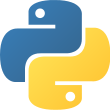Discover modern, next-generation sequencing libraries from the powerful Python ecosystem to perform cutting-edge research and analyze large amounts of biological data
Key Features
- Perform complex bioinformatics analysis using the most essential Python libraries and applications
- Implement next-generation sequencing, metagenomics, automating analysis, population genetics, and much more
- Explore various statistical and machine learning techniques for bioinformatics data analysis
Book Description
Bioinformatics is an active research field that uses a range of simple-to-advanced computations to extract valuable information from biological data, and this book will show you how to manage these tasks using Python.
This updated third edition of the Bioinformatics with Python Cookbook begins with a quick overview of the various tools and libraries in the Python ecosystem that will help you convert, analyze, and visualize biological datasets. Next, you'll cover key techniques for next-generation sequencing, single-cell analysis, genomics, metagenomics, population genetics, phylogenetics, and proteomics with the help of real-world examples. You'll learn how to work with important pipeline systems, such as Galaxy servers and Snakemake, and understand the various modules in Python for functional and asynchronous programming. This book will also help you explore topics such as SNP discovery using statistical approaches under high-performance computing frameworks, including Dask and Spark. In addition to this, you'll explore the application of machine learning algorithms in bioinformatics.
By the end of this bioinformatics Python book, you'll be equipped with the knowledge you need to implement the latest programming techniques and frameworks, empowering you to deal with bioinformatics data on every scale.
What you will learn
- Become well-versed with data processing libraries such as NumPy, pandas, arrow, and zarr in the context of bioinformatic analysis
- Interact with genomic databases
- Solve real-world problems in the fields of population genetics, phylogenetics, and proteomics
- Build bioinformatics pipelines using a Galaxy server and Snakemake
- Work with functools and itertools for functional programming
- Perform parallel processing with Dask on biological data
- Explore principal component analysis (PCA) techniques with scikit-learn
Who this book is for
This book is for bioinformatics analysts, data scientists, computational biologists, researchers, and Python developers who want to address intermediate-to-advanced biological and bioinformatics problems. Working knowledge of the Python programming language is expected. Basic knowledge of biology will also be helpful.
Table of Contents
- Python and the Surrounding Software Ecology
- Using Data Processing Libraries: numpy, pandas, arrow, and zarr
- Next Generation Sequencing
- Advanced NGS Data Processing
- Working with Genomes
- Population Genetics
- Phylogenetics
- Using the Protein Data Bank
- Bioinformatics Pipelines
- Machine Learning for Bioinformatics
- Parallel Processing with Dask
- Functional and Asynchronous Programming
 Language
Language
 Reading time
Reading time
 What you will learn
What you will learn
 Author
Author
 Published
Published
 Packages you will be introduced to
Packages you will be introduced to
